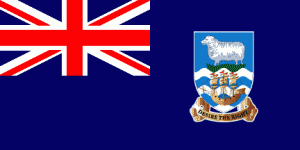
Falkland Islands
Quick reference
General issues: British colony 1878-1981, British overseas dependency 1981-2002, British overseas territory 2002-Present
Country name on general issues: Falkland Islands
Special issues: Falkland Islands Dependencies
- Graham Land 1944
- South Georgia 1944
- South Orkney Islands 1944
- South Shetland Islands 1944
- General issues 1946-1963
- South Georgia 1963-1979
- General issues 1980-1985
Currency: 1 Pound = 20 Shilling, 1 Shilling = 12 Pence 1878-1971, 1 Pound = 100 Pence 1971-Present
Population: 2 000 in 1900, 3 000 in 2012
Political history Falkland Islands
The Falkland Islands are located in the South Atlantic Ocean, about 500 kilometers from the South American mainland. The group of islands consists of the main islands of East and West Falkland and close to 800 smaller islands. The islands were uninhabited before the arrival of Europeans. The islands are first sighted by Europeans in the late 16th century and first settled in the 18th century – a French settlement, that is transferred to Spain, and a British settlement. Although these settlements are abandoned, the islands, in the early 19th century, are claimed by both Great Britain and the United Provinces of Rio de la Plata – the successor of Spain and a predecessor of the current Argentina. Eventually, from 1833, the British assert their authority over the Falkland Islands. From 1833, British colonists will settle on the islands and in 1842 the Falklands are established as a British colony. Initially the British interest in the islands is motivated by their strategic location on the shipping routes around Cape Horn, but it will, in the course of the 19th century, be sheep farming that becomes the most important activity on the Falklands.
In 1908, the British formally claim a number of islands and territories in the South Atlantic and Antarctic regions: South Georgia and the South Sandwich Islands, the South Orkney Islands, the South Shetland Islands and Graham Land on the Antarctic mainland. A claim that, in 1917, is extended to include the sector of Antarctica between the 20th and 80th degrees west longitude and south of the 58th degree of south latitude – thus including the Antarctic mainland up to the South Pole. All these territories will come to be administered as dependencies of the Falkland Islands. None of these territories have a permanent population, the temporary residents consist of government, scientific and support staff.
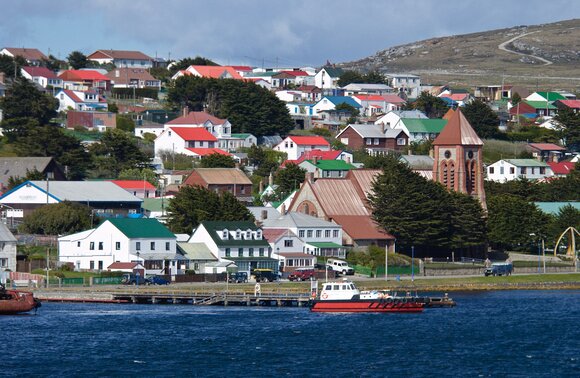
Stanley is the capital of the Falklands Islands. As such, it is the southernmost capital in the world.
The Falkland Islands dependencies will be detached again from the Falkland Islands in 1962 and 1985. First as a consequence of the Antarctic Treaty signed in 1959, effective 1961, the South Orkney Islands, the South Shetland Islands and the British sector of Antarctica are joined to form the British Antarctic Territory. The Antarctic Treaty sets aside the Antarctic as a scientific preserve and stipulates that a presence in the Antarctic does not constitute a basis for a claim to de jure sovereignty. Second, in 1985, South Georgia and the South Sandwich Islands are detached from the Falklands to form the separate territory of South Georgia & the South Sandwich Islands.
The British sovereignty over the Falkland Islands has, since the early 19th century, been disputed by Argentina. In 1982, Argentina decides to assert its claim by military force. The Falkland Islands, South Georgia and the South Sandwich Islands are occupied from April 1982. The Falklands War ends in British victory, the British regaining the Falkland Islands by June 1982. The dispute over the sovereignty over the islands has yet to be settled. In 2013, in a referendum, 99.8 % of the population voted for association with Great Britain.
With the changes in the British colonial empire, the Falkland Islands become a British overseas dependency in 1981 and a British overseas territory in 2002. As such, the Falkland Islands enjoy internal self government. Sheep farming is still an important element in the Falklands economy. From the 1980’s, the sale of fishing licences for the exclusive economic zone of 200 nautical miles around the islands is a major source of income. Finally, tourism has developed and possibilities for oil exploration are investigated.
Postal history Falkland Islands
Postal services – based on arrangements with shipping companies – have existed on the Falkland Islands since the early 19th century. The first official post offices were opened in Stanley on East Falkland in 1887 and in Fox Bay on West Falkland in 1899. The first stamps for the Falkland Islands are issued in 1878. After using Queen Victoria, King Edward VII and King George V definitives from 1933, the stamps issued are pictorials only. Most stamps issued have themes closely related to life on the Falkland Islands or are part of the omnibus issues for the British empire.
The stamps of the Falklands have, until 1944, also been used in the Falkland Islands dependencies. In 1944, sets are issued for specific use in each of the dependencies – overprints on the Falklands issues, the overprint identifying the dependency. In 1946, these are superseded by general issues for the dependencies inscribed ‘Falkland Islands Dependencies’. From 1963, the newly formed British Antarctic Territory will issue stamps of its own. Also, from 1963, stamps are issued for use on South Georgia – the one remaining Falklands dependency with a post office – inscribed ‘South Georgia’. From 1980, the Falklands postal administration again issues stamps inscribed ‘Falkland Islands Dependencies’ superseding the issues inscribed ‘South Georgia’.[1]All the worldwide catalogs list the issues for the Falkland Islands dependencies and the 1963-1979 issues for South Georgia in different ways, either as subsections of the listing for the Falkland Islands or as separate sections for the ‘Falkland Islands Dependencies’ or ‘South Georgia’. From 1985, the newly formed territory of South Georgia & the South Sandwich Islands will issue stamps of its own.
It is interesting to note that Argentina has also asserted its claims to the Falkland Islands – the Islas Malvinas as they are called in Argentina – in stamps issued. In 1982, during the Falklands War, stamps were issued with an overprint reading ‘Las Malvinas son Argentinas’. Stamps of Argentina have been used on the Falkland Islands during the occupation by Argentina.
For an overview of the political and postal developments in the Falkland Islands, please refer to the country diagram of the British South Atlantic & Antarctic Territories.
Album pages
← Previous page: Cook IslandsNext page: Fiji →

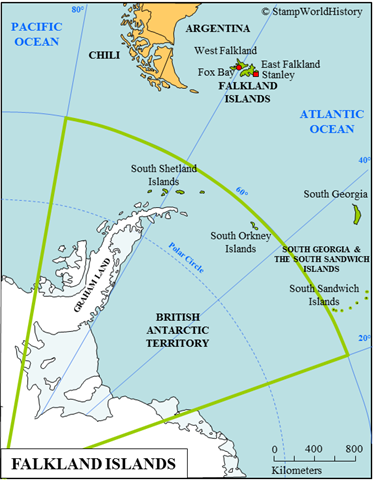
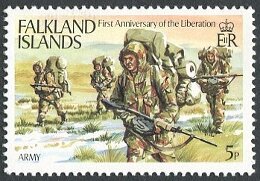
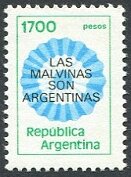

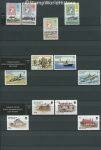


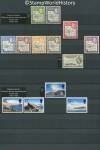

I would remove the last sentence under the photo of Stanley as there are at least 2 possible other contenders for southernmost capitals according to Wikipedia: Rothera in British Antarctic Territory and King Edward Point (sometimes called Grytviken) in South Georgia and the South Sandwich Islands
William
Interesting. I think though, I will leave the text as is. Because both British Antarctic Territory and South Georgia & the South Sandwich Islands have no permanent population, a possible claim to have the southernmost capital seems to be of a somewhat different order.